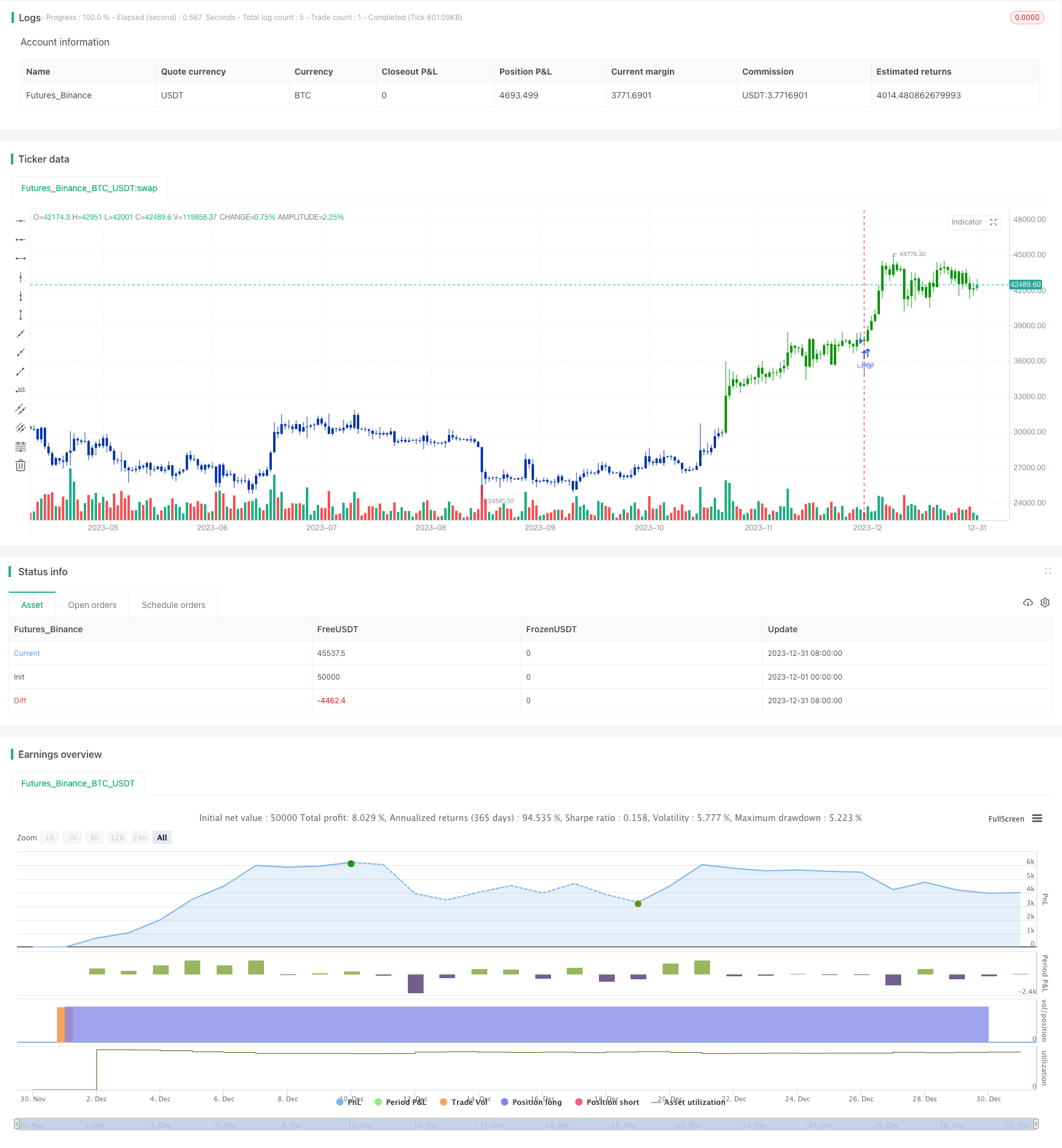
概述
本策略综合运用双机构指标的优势,采用123形态判断反转信号,辅以正量指数判断量能信号,实现对短线反转行情的捕捉。
策略原理
123形态判断反转信号
使用9日Stoch指标的快线和慢线构建
当收盘价连续两日下跌,第三日收盘价上涨时,并且Stoch快线低于50时,产生买入信号
当收盘价连续两日上涨,第三日收盘价下跌时,并且Stoch快线高于50时,产生卖出信号
正量指数判断量能信号
正量指数(PVI)通过比较前一日和今日的成交量变化判断量能
当PVI上穿其N日移动平均线时,说明量能放大,产生买入信号
当PVI下穿其N日移动平均线时,说明量能缩减,产生卖出信号
双信号综合判断
- 只有当123反转信号和PVI量能信号同向发出时,才产生交易信号
综上,该策略充分利用双机构指标的优势,能够有效识别短线量价反转机会。
优势分析
123形态判断,能够捕捉关键的短线反转点位
PVI量能指标,判断量价配合,避免假突破
Stoch指标参数优化,能过滤掉大部分躁动区域的无效信号
双信号结合,可靠度较单一信号更高
采用日内判断,避免隔夜风险,适合短线操作
风险分析
反转失败风险
- 123形态反转信号并不总是有效,存在形态失败风险
指标失效风险
- 在某些异常行情下,Stoch和PVI等指标会失效
双重信号遗漏风险
- 同向双信号条件较为严苛,可能遗漏部分单边信号机会
交易频率风险
- 策略交易频率偏高,需要密切监控仓位和风控
优化方向
参数优化空间大
- Stoch窗口期、PVI周期数等参数存在优化空间
可加入止损策略
- 可结合移动止损保证策略胜率
考虑加入过滤条件
- 可测试加入均线、波动率等滤波指标
优化双信号组合
- 可测试更多双指标的组合套利
总结
本策略通过 Stoch指标和 PVI 指标的组合,形成高可靠性的短线量价反转交易策略。相比单一指标,具有更高的胜率和正期望。通过参数优化和风控设置,可以进一步扩大夏普比率。总体来说,该策略利用双机构指标的优势,能够有效捕捉市场的短期反转机会,值得实盘验证优化。
策略源码
/*backtest
start: 2023-12-01 00:00:00
end: 2023-12-31 23:59:59
period: 1d
basePeriod: 1h
exchanges: [{"eid":"Futures_Binance","currency":"BTC_USDT"}]
*/
//@version=4
////////////////////////////////////////////////////////////
// Copyright by HPotter v1.0 22/04/2021
// This is combo strategies for get a cumulative signal.
//
// First strategy
// This System was created from the Book "How I Tripled My Money In The
// Futures Market" by Ulf Jensen, Page 183. This is reverse type of strategies.
// The strategy buys at market, if close price is higher than the previous close
// during 2 days and the meaning of 9-days Stochastic Slow Oscillator is lower than 50.
// The strategy sells at market, if close price is lower than the previous close price
// during 2 days and the meaning of 9-days Stochastic Fast Oscillator is higher than 50.
//
// Second strategy
// The theory behind the indexes is as follows: On days of increasing volume,
// you can expect prices to increase, and on days of decreasing volume, you can
// expect prices to decrease. This goes with the idea of the market being in-gear
// and out-of-gear. Both PVI and NVI work in similar fashions: Both are a running
// cumulative of values, which means you either keep adding or subtracting price
// rate of change each day to the previous day`s sum. In the case of PVI, if today`s
// volume is less than yesterday`s, don`t add anything; if today`s volume is greater,
// then add today`s price rate of change. For NVI, add today`s price rate of change
// only if today`s volume is less than yesterday`s.
//
// WARNING:
// - For purpose educate only
// - This script to change bars colors.
////////////////////////////////////////////////////////////
Reversal123(Length, KSmoothing, DLength, Level) =>
vFast = sma(stoch(close, high, low, Length), KSmoothing)
vSlow = sma(vFast, DLength)
pos = 0.0
pos := iff(close[2] < close[1] and close > close[1] and vFast < vSlow and vFast > Level, 1,
iff(close[2] > close[1] and close < close[1] and vFast > vSlow and vFast < Level, -1, nz(pos[1], 0)))
pos
PVI(EMA_Len) =>
pos = 0.0
xROC = roc(close, 1)
nRes = 0.0
nResEMA = 0.0
nRes := iff(volume > volume[1], nz(nRes[1], 0) + xROC, nz(nRes[1], 0))
nResEMA := ema(nRes, EMA_Len)
pos := iff(nRes > nResEMA, 1,
iff(nRes < nResEMA, -1, nz(pos[1], 0)))
pos
strategy(title="Combo Backtest 123 Reversal & Positive Volume Index", shorttitle="Combo", overlay = true)
line1 = input(true, "---- 123 Reversal ----")
Length = input(14, minval=1)
KSmoothing = input(1, minval=1)
DLength = input(3, minval=1)
Level = input(50, minval=1)
//-------------------------
line2 = input(true, "---- Positive Volume Index ----")
EMA_Len = input(255, minval=1)
reverse = input(false, title="Trade reverse")
posReversal123 = Reversal123(Length, KSmoothing, DLength, Level)
posPVI = PVI(EMA_Len)
pos = iff(posReversal123 == 1 and posPVI == 1 , 1,
iff(posReversal123 == -1 and posPVI == -1, -1, 0))
possig = iff(reverse and pos == 1, -1,
iff(reverse and pos == -1 , 1, pos))
if (possig == 1 )
strategy.entry("Long", strategy.long)
if (possig == -1 )
strategy.entry("Short", strategy.short)
if (possig == 0)
strategy.close_all()
barcolor(possig == -1 ? #b50404: possig == 1 ? #079605 : #0536b3 )